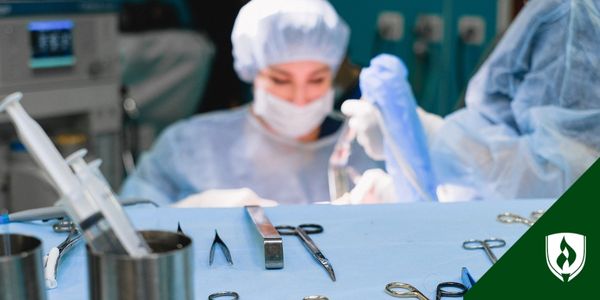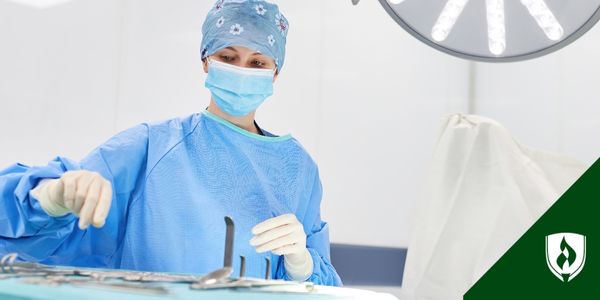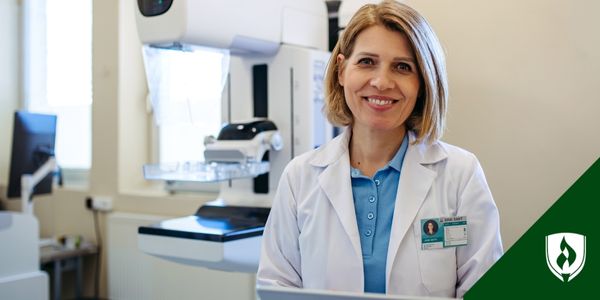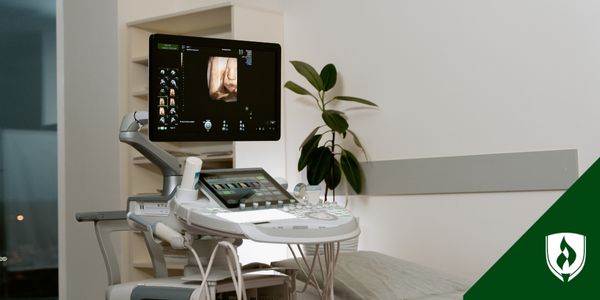Medical Lab Tech vs Radiology Tech
06/10/2025
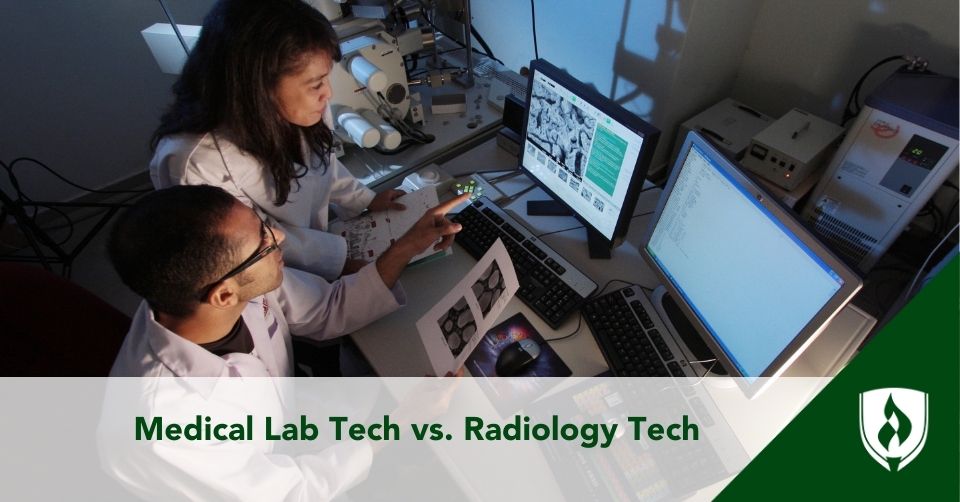
If you’re exploring healthcare careers, you may have encountered two essential roles: Medical laboratory technician (MLT) and radiology technician (RT). While both support patient care, they contribute in distinct ways — MLTs through lab analysis and RTs through imaging.
Understanding the duties, skills, educational requirements and work environment for each will help you decide which career path aligns with your interests and goals.
What Does a Medical Lab Tech Do?
Medical lab technicians play a key role1 in diagnosing and monitoring medical conditions. They work mostly behind the scenes in pathology labs, hospitals and diagnostic centers, performing clinical laboratory testing on body fluids, tissues and cells. Their expertise is in medical technology and quality control, ensuring every result delivered to other medical professionals is accurate and timely.
Day-to-day tasks may include:
- Analyzing samples using high-precision instruments
- Maintaining lab standards through rigorous quality control procedures
- Assisting in blood banking, microbiology and chemical analysis
- Reporting results to physicians to guide treatment decisions
MLTs work with medical technologists, researchers and scientists for both routine diagnostics and medical research. Their work requires attention to detail, patience and a foundation in medical sciences.
Skills for Medical Lab Technicians (MLTs)
MLTs thrive in detail-oriented, analytical environments. Their work is often solitary but essential for diagnosis and medical research.
Common skills for MLTs2 may include:
- Analytical skills: Must evaluate test specimens closely to identify any abnormalities.
- Detail-oriented: Required to strictly follow instructions and lab protocols during testing procedures.
- Dexterity: Must handle needles, specimens, and lab equipment with precision and care.
- Interpersonal skills: Often interact with anxious or uncomfortable patients and need to offer support and empathy.
- Physical stamina: May stand for extended periods and assist in lifting or positioning patients for sample collection.
The medical lab technician role is ideal for those who enjoy analyzing samples, working independently and contributing to the healthcare process behind the scenes.
What Does a Radiology Tech Do?
Radiology technicians operate imaging technology3 to visualize the inside of the human body. They capture images used in the diagnosis and monitoring of injuries, illnesses or abnormalities.
You’ll find them in hospitals, urgent care facilities, outpatient imaging clinics and nursing homes where they use x-ray, computed tomography (CT scans) and other tools to help doctors understand internal health issues.
Core responsibilities may include:
- Positioning patients for safe and effective imaging procedures
- Operating x-ray machines and other imaging technology
- Creating images while minimizing radiation exposure
- Collaborating with healthcare professionals to identify areas of concern
Because of the need for real-time decision-making and working closely with patients, radiology techs should be comfortable with physical tasks and interpersonal communication.
Skills for Radiology Techs
Radiology techs are on the front lines of medical imaging, working directly with patients and other medical professionals.
For RTs there’s a good mix of technical and interpersonal skills4:
- Detail-oriented: Must follow precise instructions to capture accurate diagnostic images.
- Interpersonal skills: Work closely with patients, often in pain or distress, requiring the ability to provide comfort and reassurance.
- Math skills: May be required to calculate appropriate levels of radiation or magnetic resonance for imaging procedures.
- Physical stamina: Spend long hours on their feet and may need to lift or assist patients.
- Technical skills: Must be proficient in operating and understanding complex imaging equipment.
This role is for those who enjoy dynamic environments, working with people and using imaging technology to visualize internal body parts.
Educational Requirements and Training
Both careers have similar foundational education:
- Medical lab technicians usually complete a program accredited by the National Accrediting Agency for Clinical Laboratory Sciences® (NAACLS®)5 and pursue certification through the American Society for Clinical Pathology® (ASCP®).6
- Radiology techs attend programs recognized by the American Registry of Radiologic Technologists® (ARRT®)7 and take the ARRT® exam to become registered x-ray technicians or RTs.
While not always required, some professionals choose to pursue a bachelor’s degree to specialize or for specific roles. Continuing education is common as technology in both radiology and medical laboratory equipment evolves.
Work Environment and Career Considerations
The work environment is a big factor:
- MLTs work in lab settings8 with regular hours. Their environment is quiet, focused and controlled. It’s for those who enjoy detail work, data analysis and a structured routine.
- Radiology techs may work irregular hours or overnight shifts, especially in 24-hour hospitals.9 The job is more physically active and involves regular patient contact during procedures.
Job Outlook and Career Opportunities
Both medical lab tech and radiology tech jobs have similar job outlook. For MLTs, the Bureau of Labor Statistics projects 5% growth from 2023-203310 and 6% growth from 2023-2033 for RTs11. Any increase in job openings may be due to workers transferring to other jobs or retiring.
- In medical laboratories, MLTs can specialize in areas like blood banking, microbiology or hematology. With experience, MLTs may seek more specialized roles or medical research.
- In radiology jobs, the ability to use specialized imaging machines opens up opportunities for advanced modalities like MRI and CT, offering more career paths down the line.
Deciding Which Path Is Right for You
Choosing between a medical lab tech and radiology tech career comes down to you:
- If you're interested in a role grounded in science, research and detail analysis, a medical laboratory career might be for you.
- If you prefer working with patients, capturing real-time internal views and operating high-tech imaging technology then a radiology technician career might be the way to go.
Both paths allow you to work with healthcare professionals and contribute to improved diagnosis and treatment outcomes.
Whether you choose medical technology or radiology technology, you’ll enter a field that requires curiosity, precision and a desire to help others.
1 Bureau of Labor Statistics, U.S. Department of Labor, Occupational Outlook Handbook, Clinical Laboratory Technologists and Technicians, "What They Do," at https://www.bls.gov/ooh/healthcare/clinical-laboratory-technologists-and-technicians.htm#tab-2 (visited Apr. 30, 2025).
2 Bureau of Labor Statistics, U.S. Department of Labor, Occupational Outlook Handbook, Clinical Laboratory Technologists and Technicians, "Work Environment," at https://www.bls.gov/ooh/healthcare/clinical-laboratory-technologists-and-technicians.htm#tab-4 (visited Apr. 30, 2025).
3 Bureau of Labor Statistics, U.S. Department of Labor, Occupational Outlook Handbook, Radiologic and MRI Technologists, "What They Do," at https://www.bls.gov/ooh/healthcare/radiologic-technologists.htm#tab-2 (visited Apr. 30, 2025).
4 Bureau of Labor Statistics, U.S. Department of Labor, Occupational Outlook Handbook, Radiologic and MRI Technologists, "Work Environment," at https://www.bls.gov/ooh/healthcare/radiologic-technologists.htm#tab-4 (visited Apr. 30, 2025).
5 National Accrediting Agency for Clinical Laboratory Sciences (NAACLS), at https://www.naacls.org/ (visited Apr. 30, 2025).
6 American Society for Clinical Pathology (ASCP), at https://www.ascp.org/ (visited Apr. 30, 2025).
7 American Registry of Radiologic Technologists (ARRT), “Exam Day,” at https://www.arrt.org/pages/earn-arrt-credentials/initial-requirements/exam/exam-day (visited Apr. 30, 2025).
8 Bureau of Labor Statistics, U.S. Department of Labor, Occupational Outlook Handbook, Clinical Laboratory Technologists and Technicians, "How to Become One," at https://www.bls.gov/ooh/healthcare/clinical-laboratory-technologists-and-technicians.htm#tab-3 (visited Apr. 30, 2025).
9 Bureau of Labor Statistics, U.S. Department of Labor, Occupational Outlook Handbook, Radiologic and MRI Technologists, "How to Become One," at https://www.bls.gov/ooh/healthcare/radiologic-technologists.htm#tab-3 (visited Apr. 30, 2025).
10 Bureau of Labor Statistics, U.S. Department of Labor, Occupational Outlook Handbook, Clinical Laboratory Technologists and Technicians, "Job Outlook," at https://www.bls.gov/ooh/healthcare/clinical-laboratory-technologists-and-technicians.htm#tab-6 (visited Apr. 30, 2025).
11 Bureau of Labor Statistics, U.S. Department of Labor, Occupational Outlook Handbook, Radiologic and MRI Technologists, "Job Outlook," at https://www.bls.gov/ooh/healthcare/radiologic-technologists.htm#tab-6 (visited Apr. 30, 2025).
